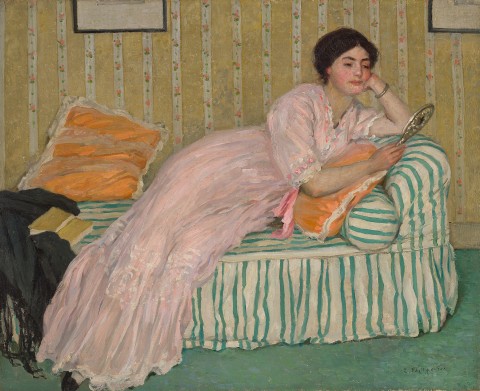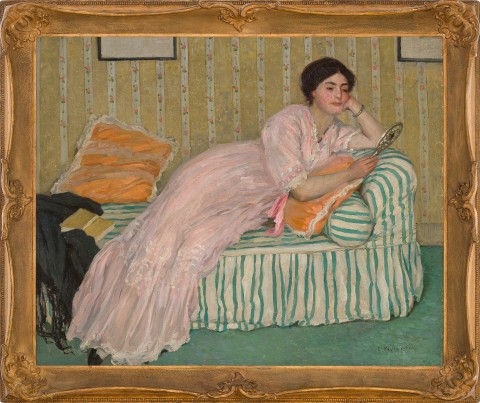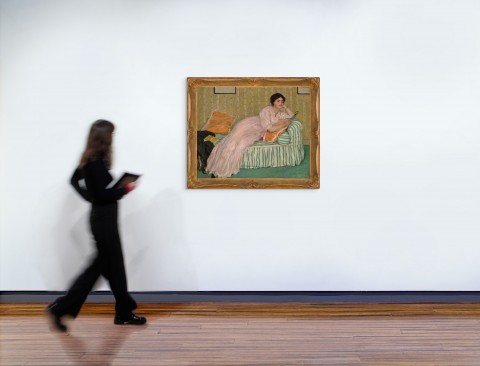VANITY, c.1912
EMANUEL PHILLIPS FOX
oil on canvas
81.0 x 100.0 cm
signed lower right: E. Phillips Fox
bears inscription on label verso: Vanity
original John Thallon frame, Melbourne
The Estate of Ethel Carrick Fox, Melbourne
Collection of Pictures by the late E. Phillips Fox and E. Carrick Fox, Leonard Joel, Melbourne, 26 September 1952, lot 33
Sir Keith Murdoch, Cruden Farm, Victoria
Thence by descent
Dame Elisabeth Murdoch, Cruden Farm, Victoria
McClelland Collection, McClelland Sculpture Park and Gallery, Langwarrin, gifted from the above in 1979
Société Internationale de Peinture et de Sculpture, Galerie Georges Petit, Paris, 6 – 31 December 1912, cat. 45 (as 'Le Miroir')
Catalogue of Paintings by E. Phillips-Fox, Athenaeum Hall, Melbourne, 17 June – 4 July 1913, cat. 12
Catalogue of Pictures by E. Phillips Fox, The Royal Art Society, Sydney, 13 – 28 October 1913, cat. 12
Catalogue of Pictures by the Late E. Phillips Fox, Upper Athenaeum Hall, Melbourne, 29 February – 18 March 1916, cat. 23
Exhibition of Oil Paintings by the Late E. Phillips Fox, Fine Art Society's Gallery, Melbourne, 22 July – 2 August 1919, cat. 16
'Mr. E. Phillips Fox's Pictures,' The Age, Melbourne, 17 June 1913, p. 8
'Mr Phillips Fox's Paintings,' Sydney Morning Herald, Sydney, 13 October 1913, p. 4
'The Work of the Late Mr. E. Phillips Fox,' The Age, Melbourne, 28 February 1916, p. 6
'Pictures by the Late E. Phillips Fox,' The Age, Melbourne, 22 July 1919, p. 6
Zubans, R., E. Phillips Fox: His Life and Art, Miegunyah Press, Melbourne, 1995, cat. 410, pp. 143, 228
Reclining Figure, c.1911, oil on canvas, 57.0 x 80.5 cm, in the collection of the University of Queensland Art Museum, Brisbane
The end of the story, c.1911-12, oil on canvas, 73.5 x 100.5 cm, in the collection of Queensland Art Gallery | Gallery of Modern Art, Brisbane
Lot 2 Phillips Fox, Reverie (1).jpg
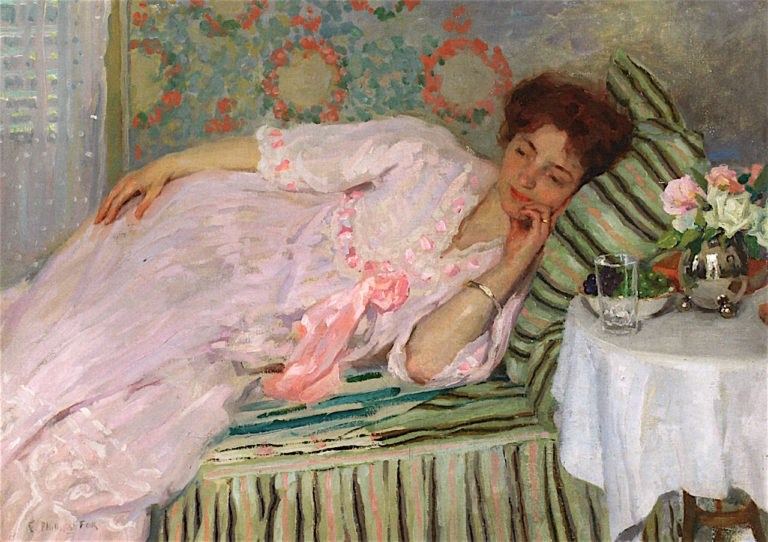
|
Emanuel Phillips Fox, Reclining Figure
c.1911, oil on canvas 57.0 x 80.5 cm
University of Queensland Art Museum, Brisbane
|
Emanuel Phillips Fox married English born Ethel Carrick in 1905, after meeting her at the artists’ colony of St Ives in Cornwall. Carrick had studied at the Slade School of Fine Art in London and had clear artistic aspirations, as well as a strong independent streak, while Fox had begun his training at Melbourne’s National Gallery School, alongside Rupert Bunny and Frederick McCubbin, later studying in Paris at the Académie Julian and with Jean-Leon Gérôme. As newlyweds, they moved to Paris, living in a studio apartment at the Cité Fleurie in Montparnasse, which was described by Carrick as ‘quite a cosmopolitan little colony of hard working artists… thirty different nationalities being represented.’1 Together the couple shared a rich, creative life, supporting each other in their artistic endeavours and ambitions and the ensuing years witnessed development and professional recognition for both artists. Upon returning to Australia in 1913 for exhibitions in Melbourne and Sydney, Fox wrote that the works he had made in the years between his marriage and that time were simply ‘the best I have painted.’2
Colour and the varied effects of light were central to Fox’s art. Indeed, as Lionel Lindsay recalled, ‘He once told me that he no longer saw anything except as a colour-sensation… His gamut of greens is extraordinary fine and varied, and the purity of his colour still holds the sunlight imprisoned in the pigment.’3 While he had been trained in an academic style, Fox always enjoyed the freedom of working outdoors, and the influence of French Impressionism – particularly as articulated by Renoir and Monet, whose work was easily accessible during Fox’s years in Paris – encouraged this, feeding in to what has been described as his natural ‘inclination towards colour, light and optical experience.’4
Lot 2 Phillips Fox, Reverie (2).jpg
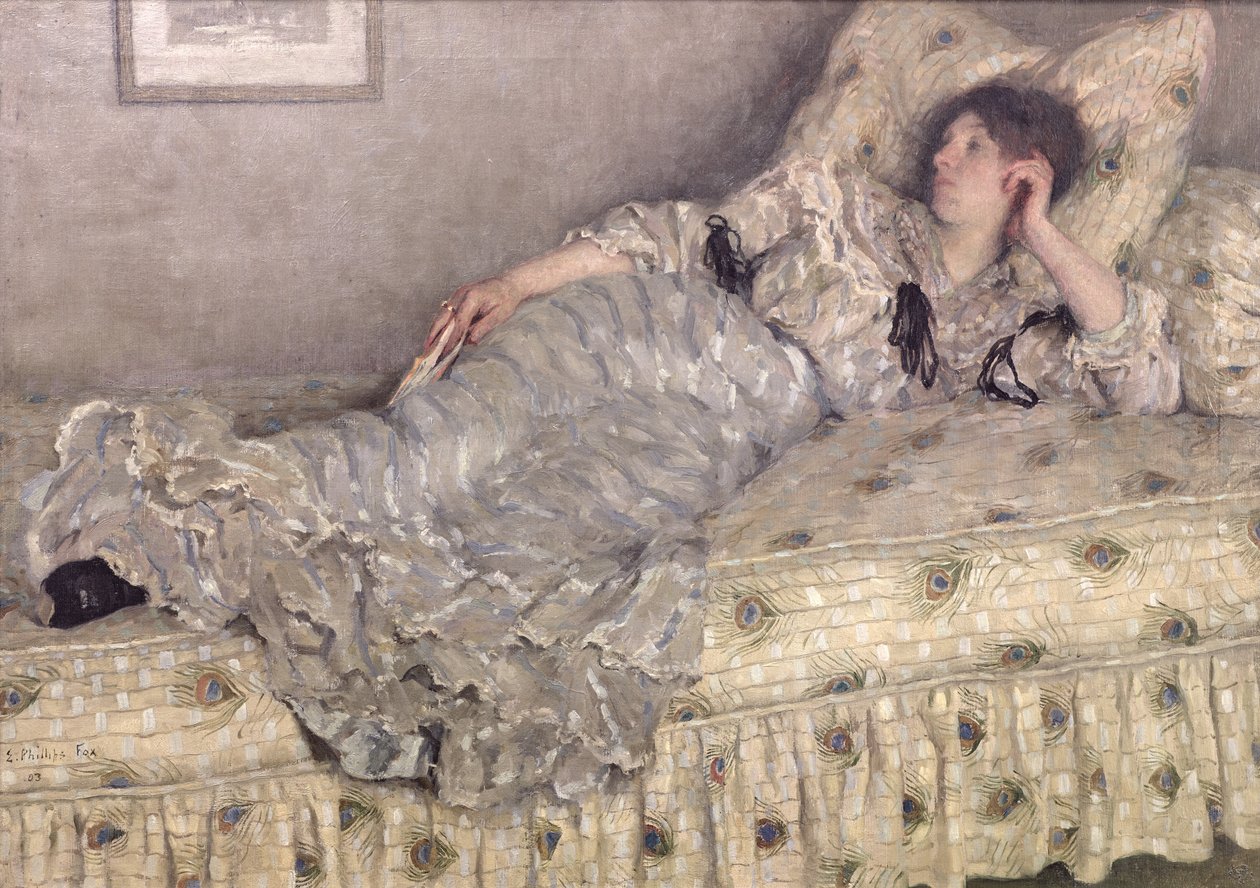
The example of the French intimiste painters, Pierre Bonnard and Édouard Vuillard, was also significant for Fox. Focussing on the figure in intimate domestic settings, their paintings are quiet and contemplative, and this influence can be seen clearly in Vanity, c.1912, which depicts a young woman lounging on a daybed, her book discarded in favour of the silver hand-held mirror which she uses to consider her reflection. The informality and intimacy of the scene – as if the viewer has just walked into the room – is emphasised by the slightly off-kilter composition of the painting and details like the framed pictures on the wall being only partially visible. Fox’s interest in the depiction of interior details and decoration, from the bold stripes of the daybed to the delicate floral-patterned wallpaper, is also clear, but what is most prominent in this work is his focus on the depiction of textiles. Juliette Peers has observed, ‘What Fox’s detailed paintings offer is the materiality of fabrics – the profile of the drape; the details of waistbands; the hanging lace of cuffs; low shoulder lines and seams… parallel rows of tucking, ruching and frilling; satin ribbon appliqués.’5 The deviations in the stripes of the upholstery, pulled tautly over the backrest or as it falls to the ground, highlights the weight and texture of this fabric, just as the form of the gently slumped cushions enables the sheen and smooth touch of their apricot fabric covers to be eloquently described in paint and easily imagined. Without question however, the star of the show is the figure’s dress, a beautiful full-length tea gown with ruffles near the hem and a pink satin ribbon detail around the neckline and sleeve ends. Typical of fashionable woman’s attire of the day, this dress appears in numerous paintings by Fox that were made around this time, from The end of the story, c.1911 – 12 (Queensland Art Gallery I Gallery of Modern Art) to Étude de nu, 1910 (private collection), where it lies crumpled in the background, apparently discarded by the languorous reclining nude who is the subject of the work.6
Bringing together the focus on pattern and texture and the use of harmonious colour which were primary elements of Fox’s approach to picture-making, Vanity is a masterful expression of his distinctive vision of fin de siècle femininity. Highly regarded by the artist, it was brought to Australia for display in his 1913 solo exhibitions here, catching the attention of the Sydney Morning Herald critic who described it as ‘a harmony in pink, blue and gold [and] among the outstanding pictures in the exhibition.’7 The painting was later purchased at auction by Sir Keith Murdoch and in 1979, Dame Elisabeth Murdoch donated it to McClelland Sculpture Park and Gallery.
1. Carrick Fox, cited in Goddard, A., ‘An Artistic Marriage’, in Art, Love & Life: Ethel Carrick and E. Phillips Fox, Queensland Art Gallery I Gallery of Modern Art, Brisbane, 2011, p. 18
2. E. Phillips Fox, cited in Downey, G., ‘Cosmopolitans and expatriates’, in Art, Love & Life: Ethel Carrick and E. Phillips Fox, ibid., p. 57
3. Lindsay, L., ‘E. Phillips Fox’, Art in Australia, series 1, number 5, 1918, cited in Zubans, R., E. Phillips Fox, National Gallery of Victoria, Melbourne, 1994, p. 1
4. Zubans, ibid., p. 3
5. Peers, J., 'Tall, graceful women sweep by’: Fashion and dress in the work of the Foxes’, in Art, Love & Life: Ethel Carrick and E. Phillips Fox, op. cit., p. 98
6. ibid.
7. ‘Mr. Phillips Fox’s Paintings’, Sydney Morning Herald, Sydney, 13 October 1913, p. 4
KIRSTY GRANT
